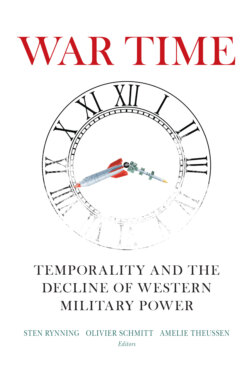Читать книгу War Time - Группа авторов - Страница 26
На сайте Литреса книга снята с продажи.
Recommendations for Policymakers and Strategists
ОглавлениеThis chapter acknowledges and embraces the idea that emerging technologies will accelerate combat at the tactical level. The emergence of hypersonic weapons, swarming attacks enabled by advances in artificial intelligence, and man-to-machine teaming will undoubtedly provide early adopters with a distinct battlefield advantage. That said, these technologies are unlikely to change the fundamental nature of warfare, nor magically offer the solution to conducting a clean, surgical, and rapid war. In fact, while recognizing the need to invest in and integrate emerging technologies into tactical operations, the chapter suggests the speed of tactical operations will produce a paradoxical slowing at the operational and strategic levels of war. The analysis points to four distinct recommendations for national leaders to repair the institutional balance between civic and martial virtue.
First, and most importantly, policy primacy is inviolate. Political leaders will feel tremendous pressure to resort to military action, as their military commanders will demand early political decisions to avoid the strategic catastrophe associated with absorbing an opponent’s initial attack. Pointing to the awesome new power of technologically advanced weapon systems, military commanders will request the delegation of authorities typically held by only the highest political leaders. Political leaders must avoid the strong temptation to act hastily and remind those clamoring to take the first punch that military action supports policy. And although policy may be the imperfect outcome of the slow, often disorganized political process, it is the foundational bedrock for establishing what operational and strategic pace the country can sustain in conflict. Both military and political leaders must be clear-eyed, neither overstating the need for early violent actions, nor falling prey to the allure of the new technology destined—at long last—to eliminate the inherent fog and friction of war and thus bring it to a speedy end.
Second, defense strategists and political leaders must invest more effort into exploring alternative second- and third-order effects of emerging technologies on the prosecution of war. Or, in simpler terms, greater emphasis must be placed on modularity, both among emerging technologies and between old and new technology. This “plug and play” aspect of technology allows battlefield military commanders opportunities to disassemble and recombine technologies in a manner demanded by the environment. The most likely uses of any technology in future war are those we cannot predict. The greatest beneficiaries of emerging technologies are therefore those most capable of rapid adaptation after the first shots are fired. Returning to the thoughts of Edward Luttwak, policymakers and military commanders should avoid technologies optimized for specific environments and instead seek “suboptimal, but inherently more resilient” technologies that lend themselves to adaptation and rapid recombination with other systems.30 The coin of the future realm will therefore be the creation of robust technological solutions, designed to cope with errors and adjustable to environments and situations engineers did not anticipate. A rich literature exists on wartime adaptation and why militaries must prepare and deliberately plan for their reaction to the unknown. As Williamson Murray suggests, “Without intellectual preparation, the adaptation that is always necessary will come at a far higher expenditure of the lives of those on the sharp end.”31
Third, defense scholars and academics must consistently push back against the calls for an offensively focused technological arms race, as such a competition may drive states toward war, rather than deterring one. In a superbly argued study, Joe Maiolo demonstrates how the pre–World War II faith in the power of offensive technology, the arms race to procure said technology, and an overwhelming belief that the side that “went first” would win led to a global war of attrition.32 The promise that a massive buildup of weapons offered political leaders eventually trapped them in their own logic. The initial speed these leaders believed necessary to win the war would be replaced by the demand for a slow, long-duration, and sustained pace. By the end of the first year, all the belligerents would go about transforming both their economy and their labor force to feed the near-unquenchable demands of war. Here it is instructive to keep Hammes’s thesis in mind and focus on the development of low-cost, highly effective defensive weapon systems that allow non-global superpowers to sustain the regional status quo without the assistance of other global powers. As in most periods throughout history, technological advances may benefit defenders rather than aggressors, minimizing yet again the importance of tactical offensive speed.
Finally, it is worthwhile for strategists, military practitioners, and scholars to keep in mind that war is fundamentally and eternally a clash of human wills. As such, any attempt to predict with any degree of accuracy how a war will unfold is a venture fraught with peril. As this chapter has demonstrated, previous attempts have been proven wrong time and time again, often leading to an outcome completely contrary to the original intent. As war represents the ultimate interaction between multiple thinking, reacting, adapting, and deceiving protagonists, it is an arena that defies predictions and instead demands broad study of alternative futures. We must understand that the concepts of victory and defeat are political terms, often transitory in nature, that require time and struggle to understand fully. Attempts to short-circuit this reality will end in failure.
We must be less enthralled by the concept of speed, especially at the operational and strategic levels of conflict. Instead we must explore more deeply the concept of pace in conflict and how a country can generate and sustain wartime efforts over time. The outcome of a marathon is rarely determined by the speed at which runners cover the first 100 meters. The same is true of warfare. Whether Western governments can act on this insight depends on how well they recalibrate the compromise between liberal principle and military virtue inside their institutions and thus enable a more patient and political approach to warfare.
